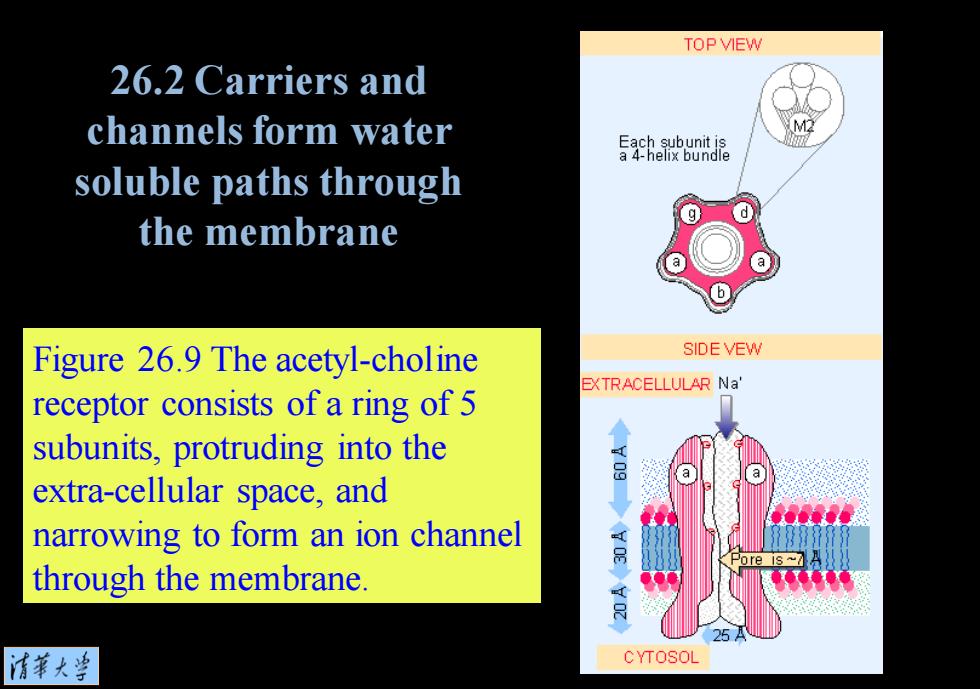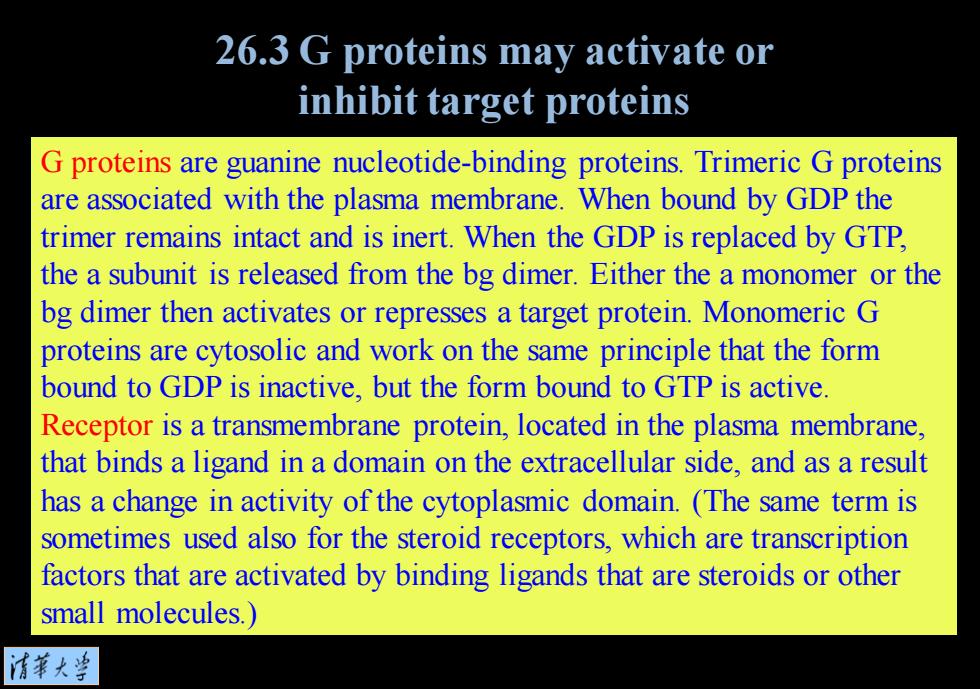
26.2 Carriers and channels form water soluble paths through the membrane EXTRACELLULAR 安& 6 88 Ball chai Figure 26.6 A potassium channel has a pore consisting of unusual transmembrane regions,with a gate whose mechanism of action resembles a ball and chain. 清菜大当
Figure 26.6 A potassium channel has a pore consisting of unusual transmembrane regions, with a gate whose mechanism of action resembles a ball and chain. 26.2 Carriers and channels form water soluble paths through the membrane

26.2 Carriers and channels form water soluble paths through the membrane Extracellular space Potassium ions Selectivity filter Central cavity Figure 26.7 The pore of a Inner pore potassium channel consists of three regions 情華大当 Cytoplasm
Figure 26.7 The pore of a potassium channel consists of three regions. 26.2 Carriers and channels form water soluble paths through the membrane

26.2 Carriers and channels form water soluble paths through the membrane Figure 26.8 A model of the potassium channel pore shows electrostatic charge (blue positive, white neutral,red negative)and hydrophobicity ( yellow).Photograph kindly provided by Rod MacKinnon. 清苇大当
Figure 26.8 A model of the potassium channel pore shows electrostatic charge (blue = positive, white = neutral, red = negative) and hydrophobicity (= yellow). Photograph kindly provided by Rod MacKinnon. 26.2 Carriers and channels form water soluble paths through the membrane

TOP VIEW 26.2 Carriers and channels form water Each subunit is a 4-helix bundle soluble paths through the membrane Figure 26.9 The acetyl-choline SIDE VEW EXTRACELLULAR Na' receptor consists of a ring of 5 subunits,protruding into the extra-cellular space,and narrowing to form an ion channel through the membrane. 情莘大学 CYTOSOL
Figure 26.9 The acetyl-choline receptor consists of a ring of 5 subunits, protruding into the extra-cellular space, and narrowing to form an ion channel through the membrane. 26.2 Carriers and channels form water soluble paths through the membrane

26.3 G proteins may activate or inhibit target proteins Gproteins are guanine nucleotide-binding proteins.Trimeric G proteins are associated with the plasma membrane.When bound by GDP the trimer remains intact and is inert.When the GDP is replaced by GTP, the a subunit is released from the bg dimer.Either the a monomer or the bg dimer then activates or represses a target protein.Monomeric G proteins are cytosolic and work on the same principle that the form bound to GDP is inactive,but the form bound to GTP is active. Receptor is a transmembrane protein,located in the plasma membrane, that binds a ligand in a domain on the extracellular side,and as a result has a change in activity of the cytoplasmic domain.(The same term is sometimes used also for the steroid receptors,which are transcription factors that are activated by binding ligands that are steroids or other small molecules. 清第大当
G proteins are guanine nucleotide-binding proteins. Trimeric G proteins are associated with the plasma membrane. When bound by GDP the trimer remains intact and is inert. When the GDP is replaced by GTP, the a subunit is released from the bg dimer. Either the a monomer or the bg dimer then activates or represses a target protein. Monomeric G proteins are cytosolic and work on the same principle that the form bound to GDP is inactive, but the form bound to GTP is active. Receptor is a transmembrane protein, located in the plasma membrane, that binds a ligand in a domain on the extracellular side, and as a result has a change in activity of the cytoplasmic domain. (The same term is sometimes used also for the steroid receptors, which are transcription factors that are activated by binding ligands that are steroids or other small molecules.) 26.3 G proteins may activate or inhibit target proteins